One of Italy’s most iconic cities, Florence has been attracting foreign visitors for centuries. If you’re planning a city break in Florence, here’s the most comprehensive online guide to Florence that you will find. With 60 fantastic things to see and do in the city, you’ll probably not have time to tick off everything but at least that will give you an excuse to return!
1. Soak in the atmosophere of the Piazza del Duomo
The Piazza del Duomo is the heart of the city of Florence and a UNESCO World Heritage site. It’s home not only to Florence’s Cathedral but also to Giotto’s Campanile, the Baptistry, the Loggia del Bigallo, the Opera del Duomo museum and the Arcivesconvile and Canonici’s palace. It’s the most visited area of the city and so any visit to Florence would not be complete without time spent in this beautiful square.
2. Visit the Duomo
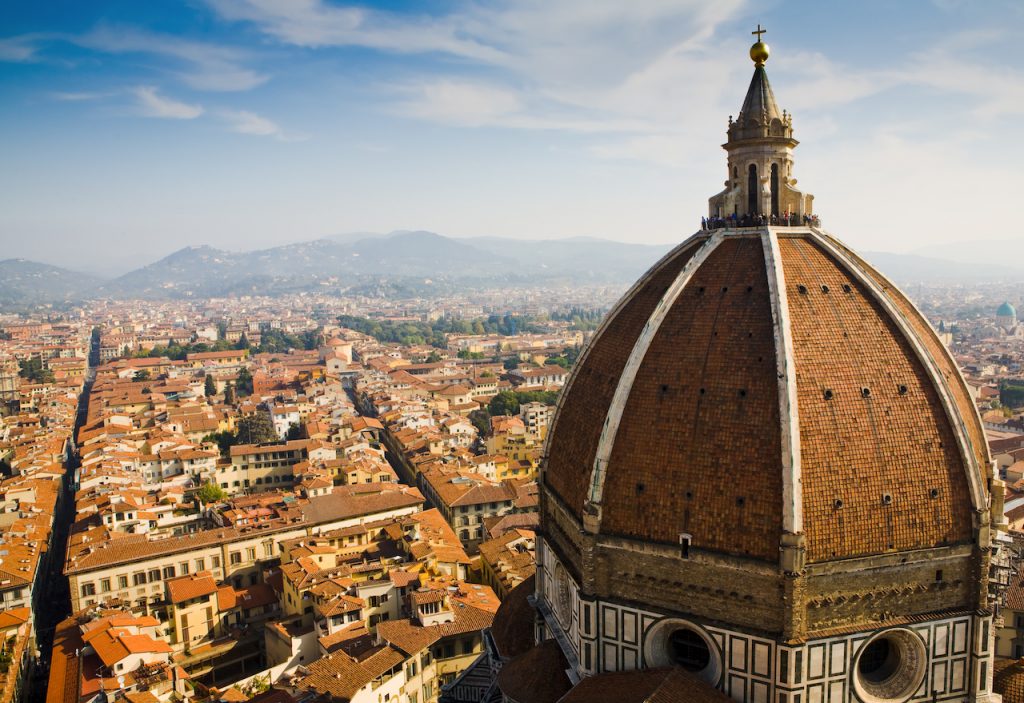
Arguably, Florence’s most famous attraction, the Cathedral of Santa Maria del Fiore and the Duomo is a great starting point for any trip to Florence. The cathedral is the 4th largest in Europe, holding a staggering 20,000 people, whilst Brunelleschi’s 15th century dome dominates the Florence skyline and is the 3rd largest dome in the world, only beaten in size by St Paul’s cathedral in London and St Peter’s Basilica in Rome. It’s incredible to think that the dome was built without any scaffolding. For those who feel they have plenty of stamina and a head for heights, it’s worth climbing the 463 steps inside the dome to enjoy the fantastic views from the top. Braving the climb will also give visitors a rather different perspective on Brunelleschi’s incredible feat of engineering.
Book your tickets for the Duomo Florence.
3. Climb the Campanile
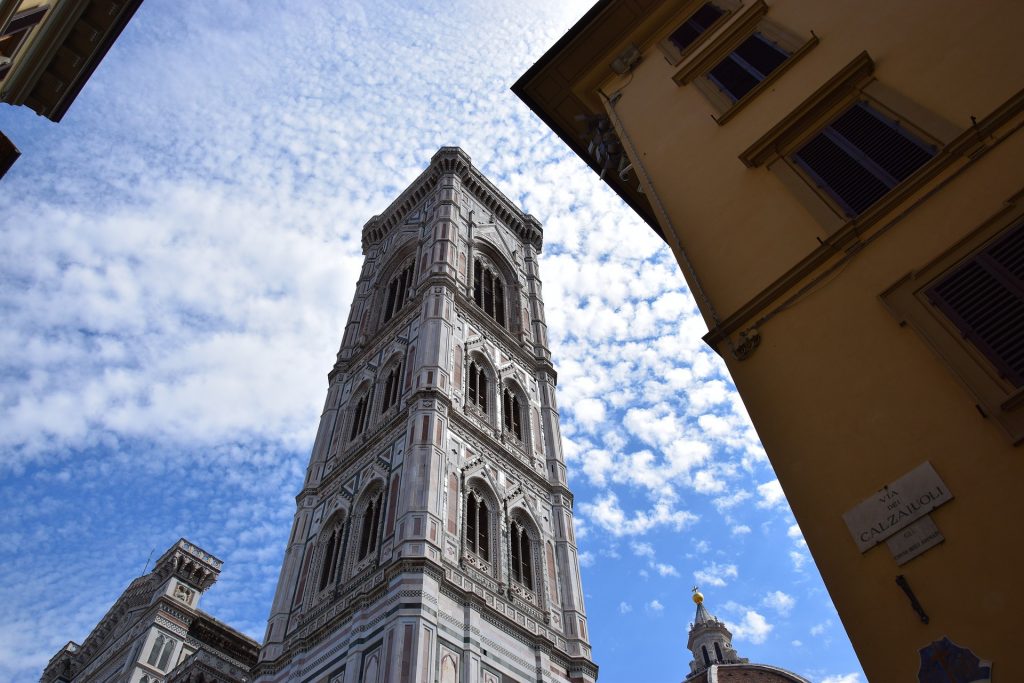
If you’d rather view the Dome itself, then another option is to climb the 414 steps of the Campanile next door. Many think that Giotto’s Campanile is connected to the Duomo but it is, in fact, completely separate. The construction took 25 years from 1334 to 1359. Unfortunately, the designer, Giotto, did not live to see its completion due to his death in 1343 so the structure was completed by Talenti. It consists of five levels and is covered with a multitude of sculptures, artworks and decorated panels.
4. Climb the Palazzo Vecchio
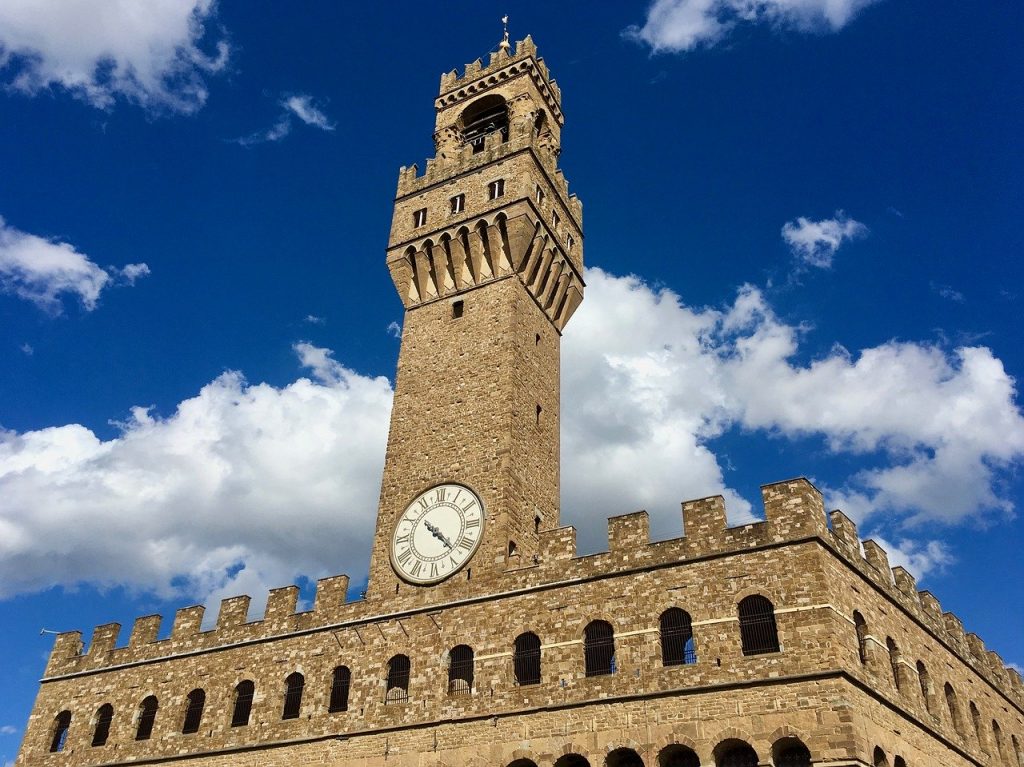
The Duomo and Campanile aren’t the only viewpoints you can climb in Florence. Another option is to climb the Palazzo Vecchio. Just like from the top of the Campanile, this will give you the chance to enjoy excellent views of the Duomo itself.
Book your tickets to the Palazzo Vecchio with Tower Access.
5. See where Dante was baptised
Opposite the Duomo stands the Baptistry of San Giovanni. One of the oldest buildings in Florence, it is arguably most famous for its bronze doors and precious mosaics on its ceiling which depict the Last Judgement. However, it is also home to an octagonal font where many famous Florentines have been baptised, among them the author, poet, philosopher and political thinker, Dante.
6. See the original Baptistry Doors
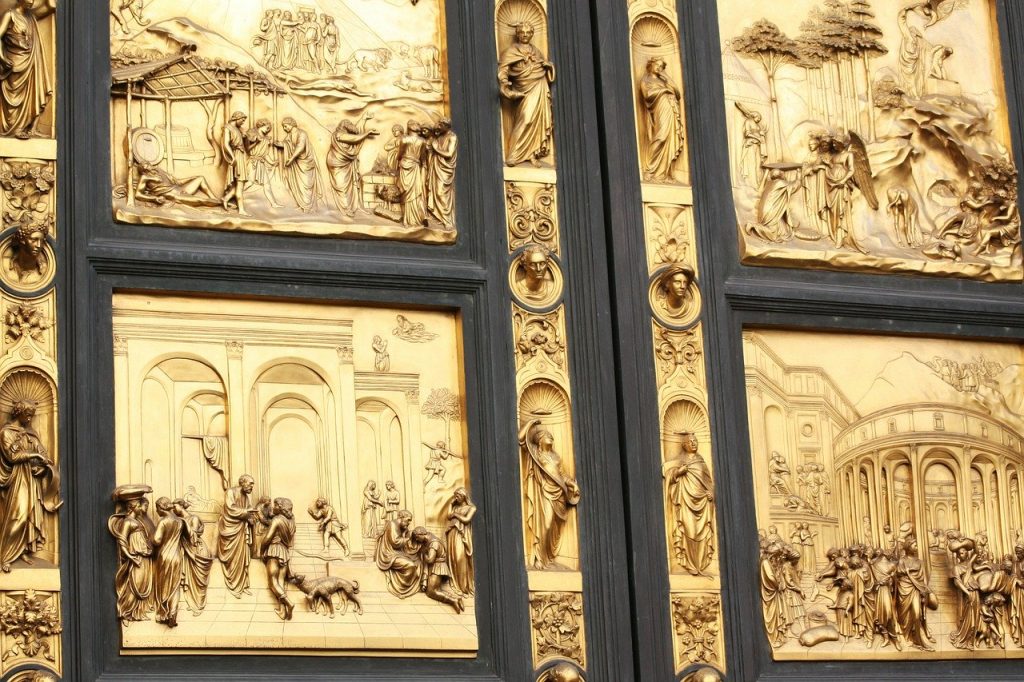
Whilst you can see the famous, ornate bronze doors on the Baptistry, these are in fact replicas of the original which are to be found in the Museo dell’ Opera. The doors were designed by Lorenzo Ghiberti who won a competition in 1401. Once complete, Michelangelo called them the ‘Gate of Paradise.’
7. Discover the artworks in the Uffizi
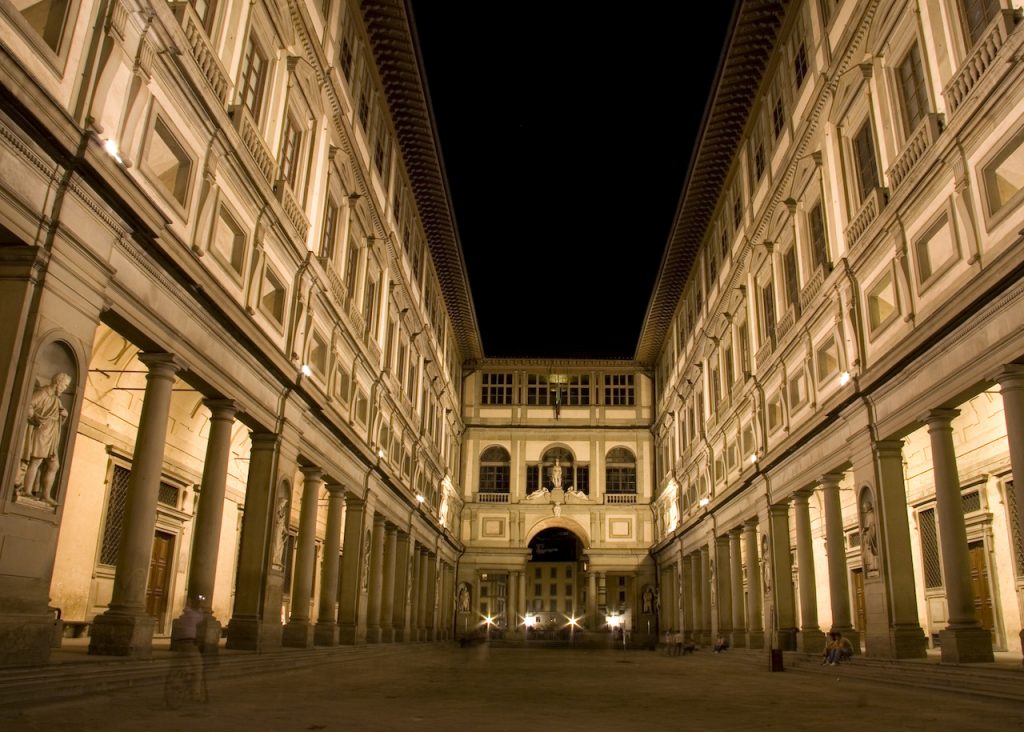
The Uffizi must class as Italy’s best art gallery and, not surprisingly, attracts a staggering amount of visitors each year. Visitors can admire works of art dating from the 12th century to the 17th century, including a plethora of artists from Giotto to Paolo Uccello, from Boticelli to Titian and from Leonardo da Vinci to Rubens and Michelangelo. We recommend buying your ticket in advance to avoid the lengthy queues. It is possible to turn up first thing and queue for next day tickets but since only 200 tickets are allocated in this way, we suggest you try out some of our recommended sites to book your tickets or to organise your personal tour guide in advance:
8. Hit the shops!
Florence is home to some of Italy’s most famous designer brands. Head to the main shopping street – Via de’ Tornabuoni – to find the showrooms of Italy’s top fashion designers including Dolce and Gabbana, Armani, Prada and Gucci. If your budget doesn’t stretch to the top brands, there are plenty of cheaper high street options. Or head half an hour outside the centre of the city and you will come across two factory outlets where you will find high end brands at knock down prices. These include McArthurGlen’s Barberino Designer Outlet to the North of Florence or The Mall Florence to the South.
9. View a more modern take on art
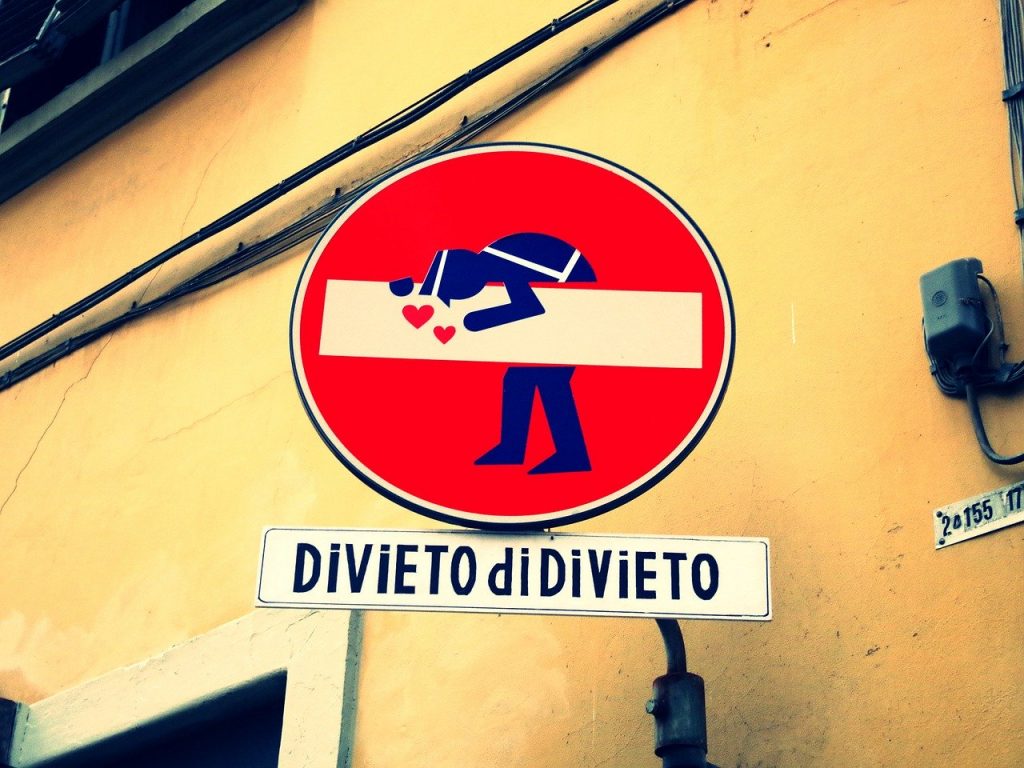
There are arguably no cities in the world with such a rich history of art as Florence. However, a contemporary artist – Clet Abraham (known as CLET) has found his own way to bring art to the masses. Using removable stickers, the artist adapts the street signs in Florence. Meet the man himself at his studio in the San Niccolo neighbourhood and see if you can spot some of his artworks as you explore the city.
For those with an interest in art, it is possible to book a street art tour of Florence where a guide will show you Florence’s art scene that exists on its streets, outside its historic museums.
10. Walk across the Ponte Vecchio
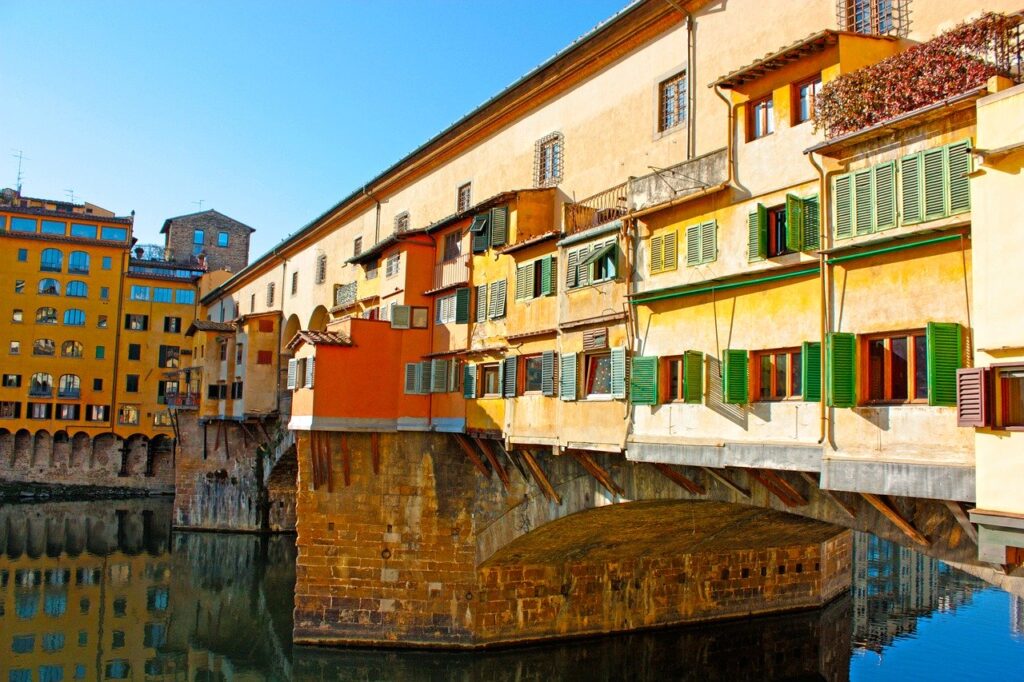
Whilst several bridges span the River Arno, the most famous of these is certainly the Ponte Vecchio which spans the river at its narrowest point. It is also the oldest surviving bridge in Florence dating back to 1345 and is famous for the many small shops that line its sides. Originally these spaces would have been occupied by butchers, blacksmiths and tanners but these days, it’s home to jewellers and goldsmiths. Whilst the other bridges in Florence were destroyed in WWII during the German retreat, the Ponte Vecchio was spared, supposedly on Hitler’s orders. Sitting above the bridge is the Vasari Corridor, built by Vasari on the orders of Cosimo I de Medici in 1565 to connect the Palazzo Vecchio with the Palazzo Pitti.
11. Take a stroll across the Ponte Santa Trinita to get views of the Ponte Vecchio
The Ponte Santa Trinita is the neighbouring bridge along the River Arno and a walk across will give you the most wonderful views of the Ponte Vecchio.
12. Discover how gelato is made
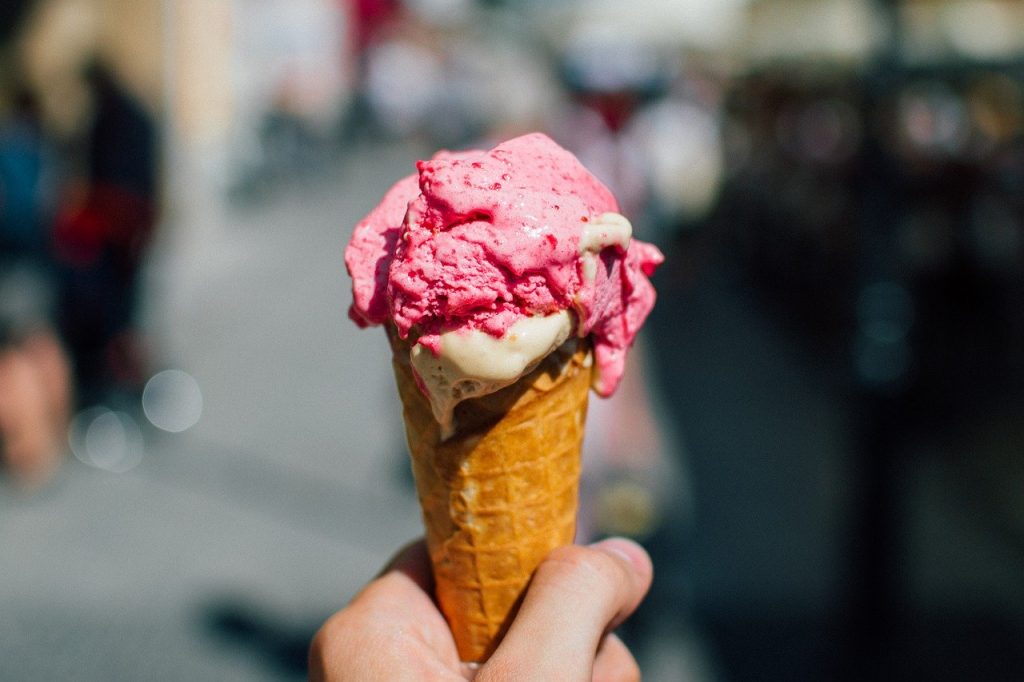
As in many big cities, there are plenty of great experiences and guided tours to enjoy. One of our favourites involves a lesson on how to make gelato. Gelato experts will guide you through the history of this incredibly moreish treat (some arguing that Florence invented gelato in the 16th century when they shipped blocks of ice down from the Apennine mountains) and will show you how to make gelato from scratch. If you’re happy just to eat gelato than make it, then we can recommend a trip to Vivoli Gelato, one of Florence’s oldest gelataria.
Book a gelato making class in Florence.
13. Smell the roses!
The Giardino delle Rose is a park situated in the Oltano district of Florence on the Southern slopes of the Monte alle Croci, designed by Giuseppe Poggi and home to over 350 different varieties of rose as well as lemon trees and a Japanese Oasis. Entry is free of charge. If you can, visit in May and June when the roses will be in full bloom. The gardens are also home to a collection of sculptures by Belgian artist Jean-Michel Folon. As an extra bonus, visitors will also be treated to some wonderful views of the city from the gardens.
14. Visit the Iris Garden
Roses aren’t the only flowers to enjoy their own garden in Florence. Florence is also home to the Iris Garden. Again, try and visit in May when the flowers will be in bloom.
15. Watch the sunset from the Piazzale Michelangelo
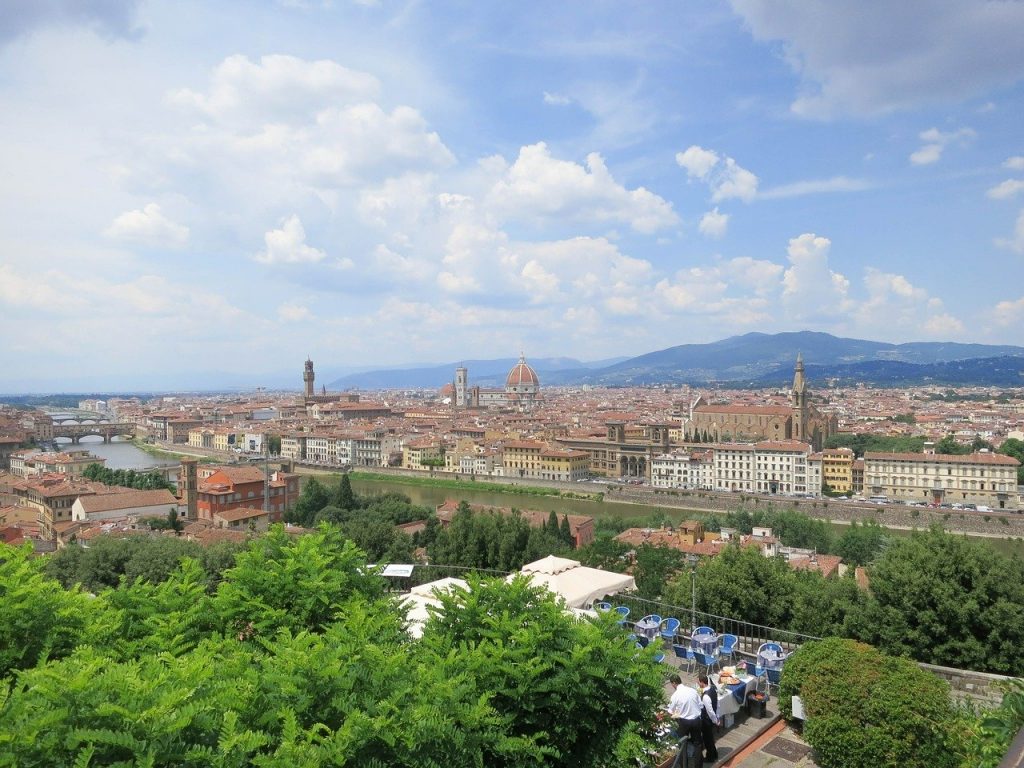
It’s worth heading to the Piazzale Michelangelo to enjoy the wonderful sunset and spectacular views over the city. Visit on a clear day and you will enjoy views of many of the bridges that span the River Arno including the Ponte Vecchio as well as the Duomo and Palazzo Vecchio. The piazza was the work of 19th century architect, Giuseppe Poggi, and is dotted with copies of sculptures by Michelangelo. A building behind was originally intended as a museum for works by Michelangelo but is now a café and restaurant.
16. Hike to San Miniato al Monte
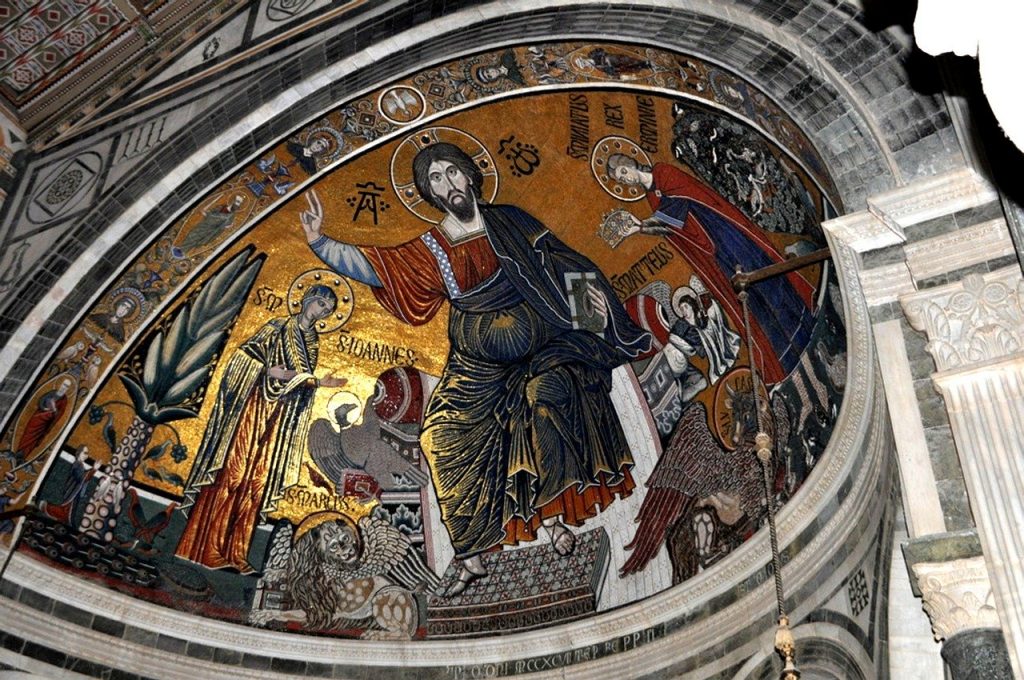
For an even more spectacular view of the city below, head further into the hills that surround Florence to the church of San Miniato al Monte. The view from the front of the church is incredible (and if you visit in late April or early May you will also enjoy views of the Iris Garden) but the church itself is also worth seeing. It is arguably one of the most beautiful Romanesque churches in Italy, built in the 11th century over the shrine of San Miniato. Watch out for the floor of the nave which is covered with mosaics depicting animals and signs of the zodiac.
17. Use Florence as a base to explore rural Tuscany
Florence can boast excellent public transport links and it is easy to use the city as a base to explore the rest of this beautiful region. Catch a train or bus to San Gimignano to view its famous towers, to Pisa to admire its leaning tower or to Lucca to walk around its walls.
There are plenty of day tours from Florence to choose from, including tours of rural Tuscany, day trips from Florence to Cinque Terre and trips to Tuscany’s other main cities such as Pisa, San Gimignano and Lucca.
18. Play a round of golf

A round of golf is probably not what first springs to mind when visiting Florence, but there are two superb golf courses just 20 minutes from the heart of the city. South of the city, the Ugolino golf course is the oldest in Tuscany and enjoys spectacular views over the Tuscan countryside. In the opposite direction, to the North of Florence, is the Poggio dei Medici golf course.
19. Enjoy a wine tasting experience
So many regions of Italy are famous for their wine production and Tuscany is no exception. The region boasts a great variety of both white as well as red wines, including Brunello di Montalcino, Sangiovese, Sassicaia, Tignanello, Chianti Classico and more. We can definitely recommend trying them out at one of the many wine cellars and vineyards in Tuscany, several of which are just outside Florence. Or why not enjoy a walking tour of the city that has wine tasting at its heart? Get Your Guide have several options for both wine tours in the city centre and in the countryside surrounding Florence.
20. Spend a night at the opera
Florence is home to a number of theatres, the oldest of which is the Teatro Niccolini which dates back to the mid 17th century. At the other end of the chronological spectrum, the Opera di Firenze is the newest theatre in the city and plays hosts to Maggio Musicale Fiorentino each year. The event takes place between late April and June and typically features four operas. Other theatres in the city include the Teatro Puccini, Teatro Verdi and Teatro della Pergola.
21. Enjoy a cookery class or chef service
Bookings For You can organise a cookery class for any of our guests in Florence. Please let us know if you would like us to help organise this for you. We are proud to work with Gianluca and Laura from Cooking in Florence. Both trained chefs, they each bring a different cooking style to the mix to create a wonderful fusion of tastes. They can also organise a private chef service for those enjoying self-catering accommodation in Florence. Mention ‘Bookings For You’ to receive an exclusive discount when booking.
Book a cooking class in Florence.
22. Visit the markets
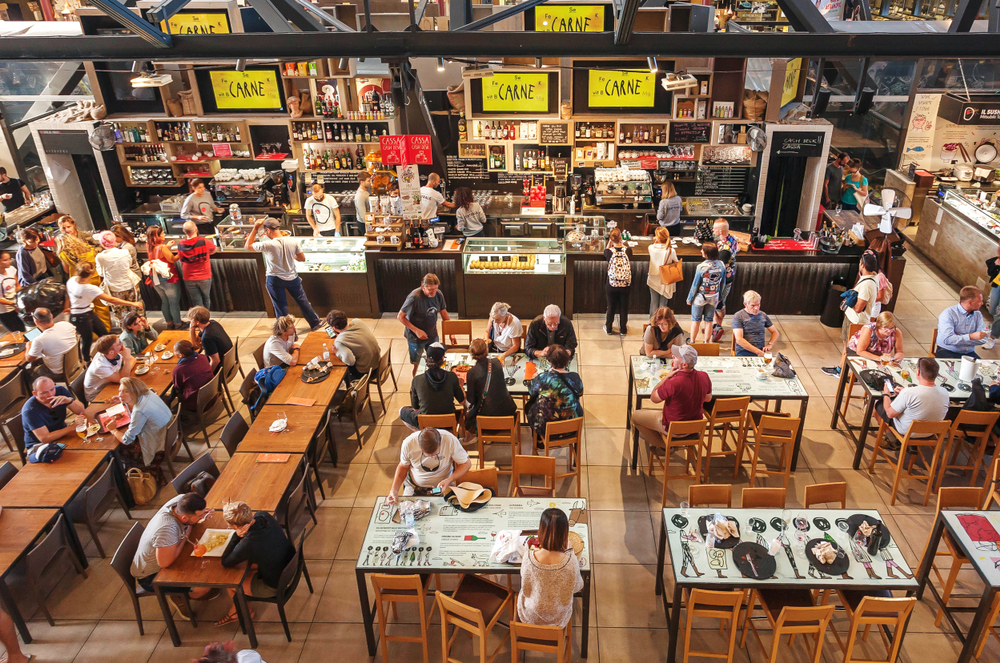
Another way to try the local foodstuffs is to shop at one of the many weekly markets during your stay in Florence. You’ll pick up some incredible meat, fish, fruit and vegetables here as well as clothing, shoes and leather goods. Markets typically run in the morning and it’s worth heading early to get the pick of the produce. The biggest food market in Florence is the Mercato Centrale. Laid out over two floors, you’ll find meat, poultry, fish, ham, oil and cheese on the ground floor whilst upstairs is a restaurant and bar area where you will find several food stalls selling delicious food and drink. There is also a cookery school here and there is another pizzeria and restaurant on a mezzanine level. The Mercato Centrale is not the only market worth visiting though. Other markets in the centre of the city include the Mercato delle Pucli, the Mercato Nuovo, the Mercato San Lorenzo and the Mercato Fierucola.
23. Spend a day at the swimming pool
If you want to cool off from the heat of the Summer sun, then it is possible to do so even in the heart of the city. Florence has a number of outdoor pools. However, the biggest of these is the Piscina Comunale Costoli where you will find not one but two outdoor swimming pools. One of these is an Olympic size pool perfect for those looking to do lengths whilst the other is ideal for younger children as well as adults. The larger pool also has a diving platform. Surrounded by green lawns, there is ample space to sit and relax and top up the tan.
24. Visit the Church of Santa Maria Novella
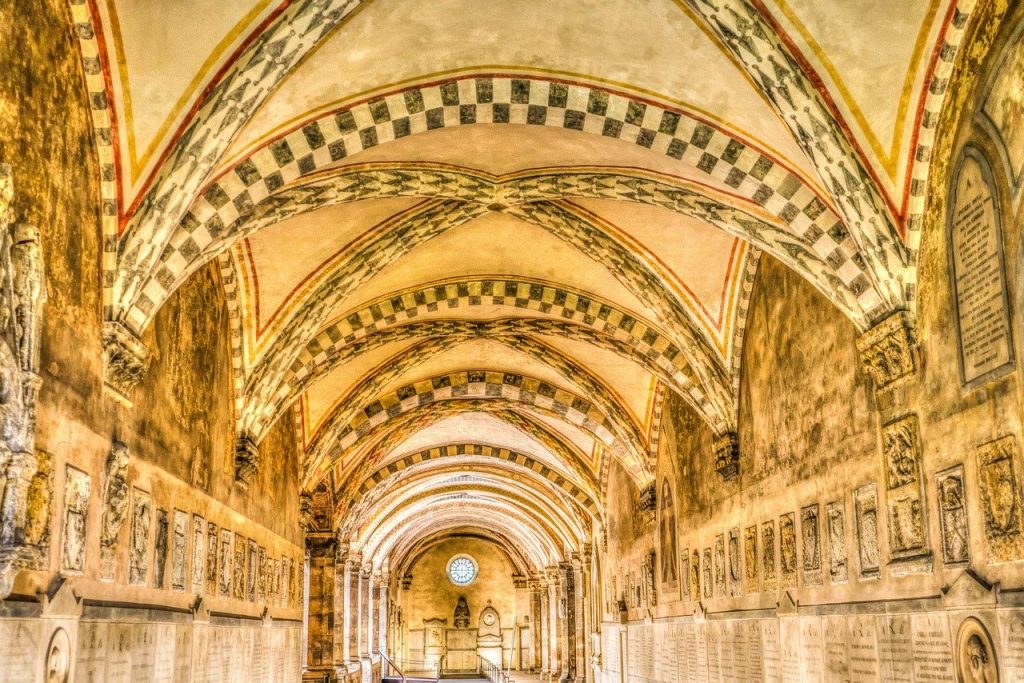
Situated opposite the main train station in Florence, this church was built in the 13th and 14th century. Inside, there is a Gothic crucifix by Giotto as well an early Renaissance fresco by Masaccio of the Trinity. Believed to date from 1427, it is hailed as one of the earliest examples of the Renaissance use of perspective.
25. View the Roman remains at the Palazzo Vecchio
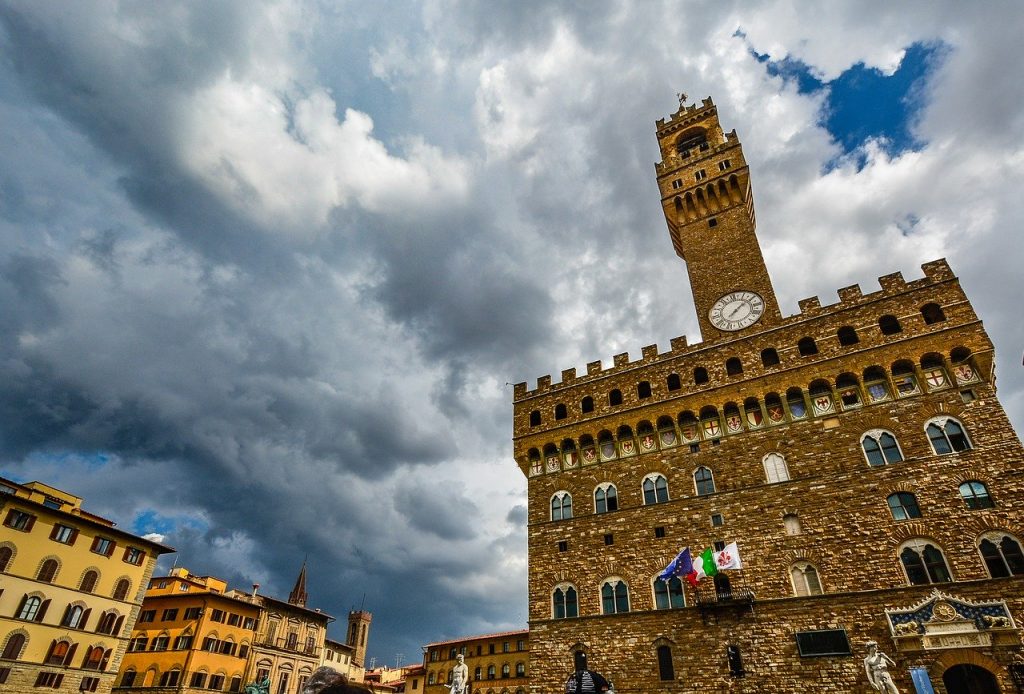
The Palazzo Vecchio is Florence’s town hall. It was built in the 13th and 14th century, but the construction was built on top of the ancient Roman theatre. Luckily, visitors can still see the ancient remains today. However, the Palazzo Vecchio also offers a glimpse of later history. Don’t miss the Salone dei Cinquecento (Hall of the Five Hundred) which is a magnificent hall within the palace measuring a staggering 54 metres long and 23 metres wide, with a ceiling height of 18 metres and decorated with beautiful frescoes. Also of note in the Palazzo Vecchio is the series of rooms called the Quatieri Monumentali which are decorated by artists such as Michelangelo, Vasari and Donatello as well as the Hall of Maps. Here you will find an enormous rotating globe (Mappa Mundi) and dozens of maps painted on leather showing how the world was seen in the mid 16th century.
Book your audio guide tour and tickets to the Palazzo Vecchio.
26. Admire the life-size nativity scene
If visiting in the run up to Christmas, then you will find Florence beautifully decorated. Shop windows are wonderfully festive and from 8 December, you’ll find an enormous Christmas tree in the Piazza del Duomo along with a nativity scene, constructed from locally made, life-size terracotta statues.
27. Visit the Christmas markets
Whilst Florence has a plentiful number of markets to enjoy all year round, it’s worth visiting in the run up to Christmas to enjoy the atmosphere, hustle and bustle of the Christmas markets. The largest and most famous of these is the Christmas market in the Piazza Santa Croce which runs from the end of November. Similar in style to the traditional German markets, little wooden huts are home to a plethora of stall holders selling everything from crafts to furnishings and from food to Christmas gifts.
28. Go ice skating
Another option to enjoy in the run up to Christmas is to go ice skating in Florence. The Palaghiaccio ice-skating rink is an annual feature in Piazza Liberta and is an idyllic spot to get you in the festive spirit. Or, in the East of the city, the Obihall plays host to the Florence Winter Park with skating on offer between the months of November and February. You’ll find 2 rinks here, one larger for adults and more serious skaters as well as a smaller one for younger skaters. There is even an opportunity to enjoy a sport called ‘ice stock’ which is similar to curling. In 2019, Florence was also home to the Florence Ice Village in the Fortezza gardens, which boasted to be the longest ice-skating rink in Europe at around 320 metres long.
29. Explore Florence on two wheels by bike or by segway
With much of central Florence closed to traffic, getting around by bike can be a great option to explore the city. A government run scheme called ‘Mille e una bici’ allows you to rent a bike in the heart of Florence by the hour. Just pick up your bike from one of four pick up points – at the main railway station, at Piazza Santa Croce, at the Sant’ Ambrogio market or the Stazione FS Campo di Marte – and choose to rent for 1, 5 or 24 hours. Even if you’re not that active normally, or for those who are filled with dread at the thought of hours pedalling up and down Florence streets, you can hire e-bikes in the city too. These are a fantastic way to explore the area without the effort required on a ‘standard’ pedal bike.
A great way to see the city is also to take a guided bike tour of Florence. It’s a great way to see all the main sights as well as some hidden gems, all the while getting the insider secrets from your knowledgeable tour guide.
Or, another fun way to see the city is to enjoy a segway tour of Florence. You’ll see the main sights from a unique vantage point.
30. Take a vespa tour
Cycling isn’t the only way to get about the city. Another option is to join the locals, hire a scooter and zip around the city this way instead! A good option is to hire vespas to get you to Fiesole which sits high above Florence. Here you can explore the remains of a Roman theatre and Roman baths as well as the convent of San Francesco.
Book your vespa tour of Florence.
31. Ride the carousel
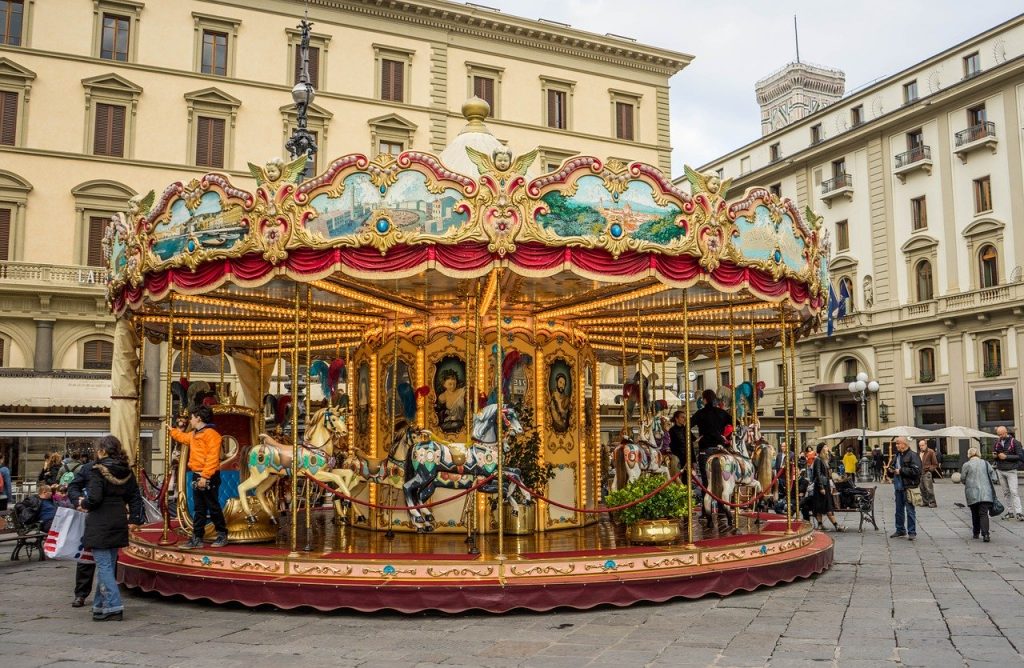
A permanent fixture in the Piazza della Repubblica in Florence is an antique carousel dating from the beginning of the 20th century. Brightly decorated with 20 horses and two carriages, the carousel belongs to the Picci family. Around the top, you will find panels of various cities in Italy. This is a carousel ride you are never too old to enjoy!
32. Explore the Palazzo Pitti
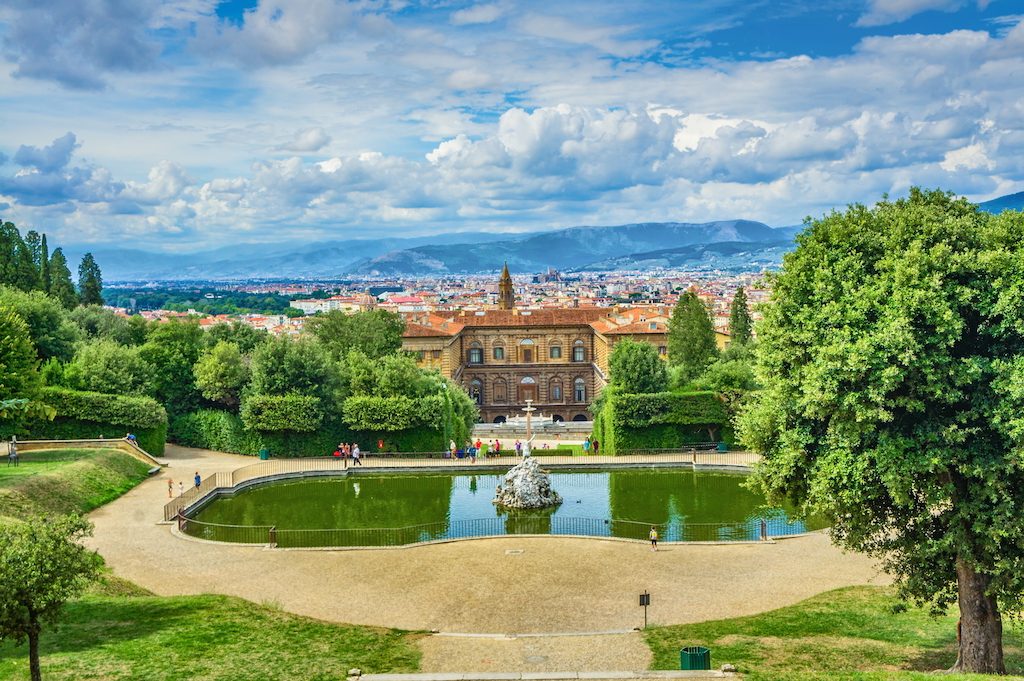
The Palazzo Pitti was once the home of the Medici family and in subsequent years was also the court of two other famous dynasties – the House of Habsburg-Lorraine and the House of Savoy. The Renaissance palace sits on the South side of the River Arno at the foot of the Boboli hill. Nowadays, the palace is divided into four museums. On the ground floor is the Treasury of the Grand Dukes where you can find some of the family’s incredible silverware and porcelain. The Galleria Palatina (Palatine Gallery) and the Appartamenti Reali (Royal apartments) are on the first floor. The former is home to numerous masterpieces including works by Titian, Tintoretto and Botticelli whilst the latter is extremely ornate and home to some beautiful 17th century frescoes and some 18th and 19th century tapestries. Finally, on the second floor is the Galleria d’Arte (Gallery of Modern Art) and the Galleria del Costune (Museum of Costume and Fashion).
33. Wander around the Boboli Gardens
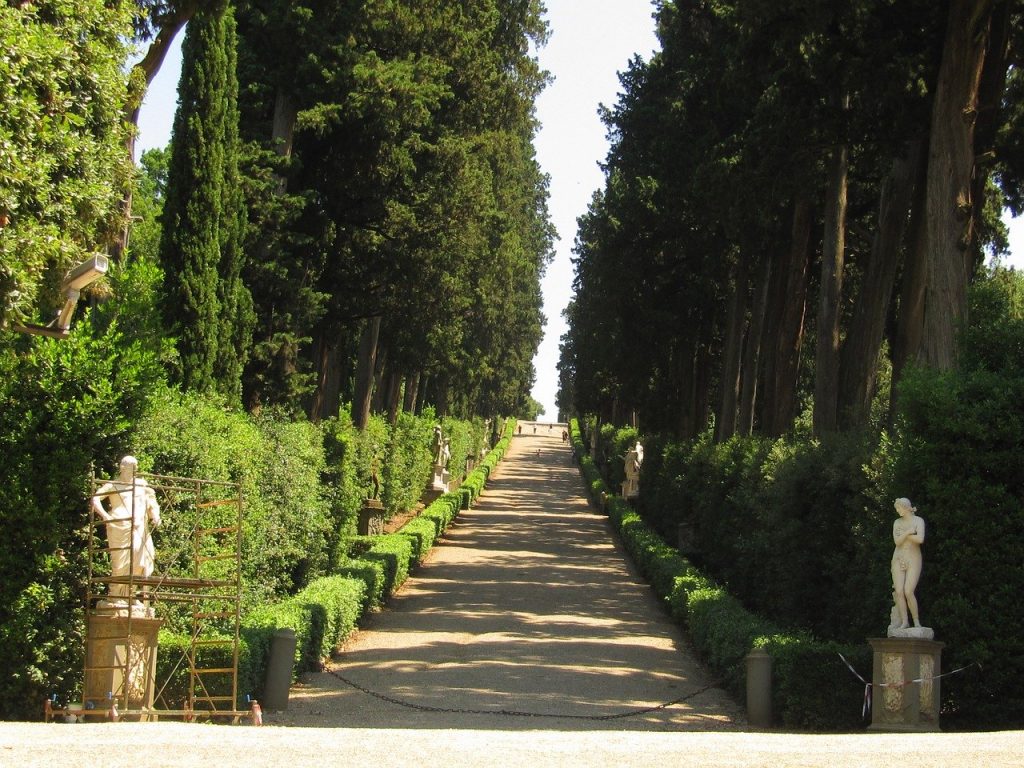
If visiting the Palazzo Pitti, you can’t miss the opportunity to take a stroll through the Boboli Gardens. A perfect example of a Renaissance garden and again the creation of the Medici family, the gardens are filled with neatly clipped hedging, blooming flowers, ancient oak trees, tall cypress trees, grottos, fountains and statues. Probably the most famous of these include the Grotta Grande by Bernardo Buontalenti, the Fountain of Neptune and the Fountain of the Ocean. Since its creation in the mid 16th century, the garden has been changed and added to over the years and is now also home to an 18th century pavilion that overlooks a beautiful terraced area, a Lemon House and amphitheatre. It’s also where you will find Florence’s porcelain museum.
Book a guided tour of the Boboli Gardens.
34. Stroll through the Bardini Gardens
The Bardini Gardens are probably the least well known of any of the gardens in Florence, but they are no less magical. Try and visit mid to late April when you have the best chance of walking underneath the wisteria tunnel in full bloom however there is much to enjoy here all year round and other plants that you can admire include azaleas, camellias and roses, as well as numerous fruit trees and hydrangea, of which there are more than 60 varieties. There is also an Anglo-Chinese garden at the top of the garden where a fountain in the shape of a dragon feeds a canal. The gardens themselves are built on several terraces, each one offering new and wonderful panoramic views over Florence, with the most spectacular views offered from the terrace in front of the garden’s restaurant and café.
35. Enjoy a fine dining experience
For the meat lovers amongst you, one of the dishes you mustn’t miss out on trying when in Florence is the famous bistecca alla Fiorentina. The steaks are huge (typically weighting 1.5 to 2 kg and 3-4 cm deep) and you might find you need to share one between two to get through it! However, as well as traditional authentic cuisine, when in Florence, holidaymakers also have the opportunity to enjoy a fine dining experience at one of the Michelin star restaurants that the city offers. Florence can boast no less than 8 Michelin starred restaurants in 2020.
36. Discover the Da Vinci museum
This is a particularly good option for younger family members. The museum brings the work and genius of Leonardo da Vinci to life. Staff have built a series of machines entirely of wood using the original Da Vinci drawings. Children can happily play with the models as much as they like, turning wheels and watching the gears and mechanisms in action on anything from a crane to a machine gun. Overall, the museum is divided into five sections – mechanisms, earth, water, air and fire – each looking at a different scientific principle.
37. Relax in the spa for the afternoon
If your legs are tired from pounding the streets or you’re in need of a bit of rest, why not indulge in a spa treatment, whether just to relax or for the health benefits that treatments can offer. There are a number of spas in Florence offering a wide range of treatments ranging from beauty treatments to massages, from Turkish baths to saunas, from exfoliating treatments to facials and from hair styling to manicures.
38. Visit the church of Santa Croce
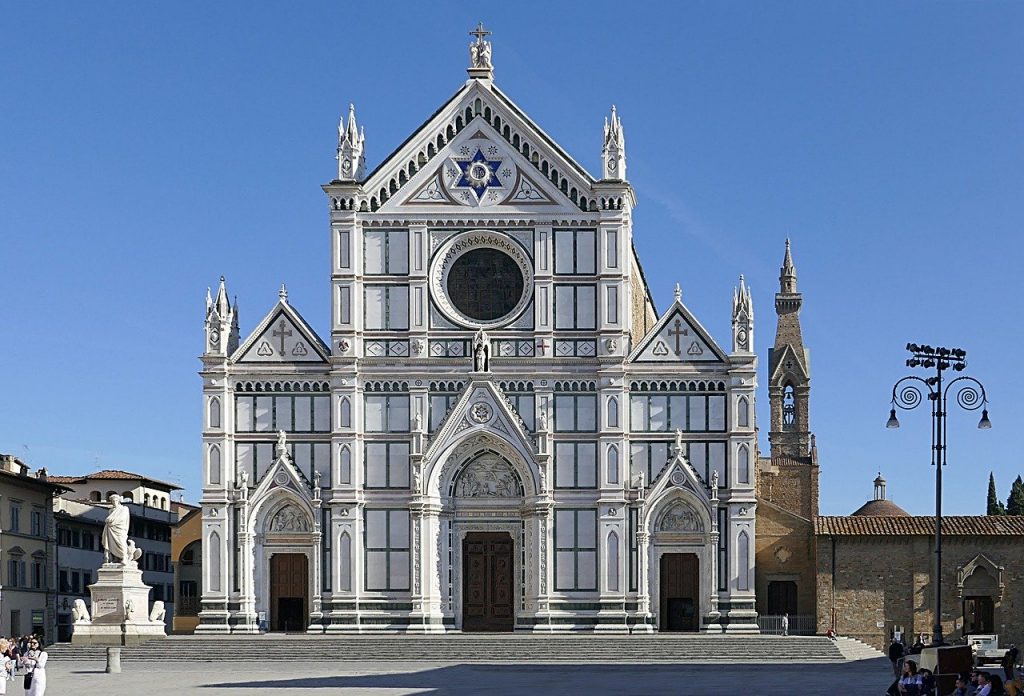
The Basilica di Santa Croce is considered to be the largest Franciscan church in the world and is the resting place for several eminent Florentines, including Michelangelo, Rossini and Machiavelli, as well as for Pisan born astronomer, physicist and engineer, Galileo Galilei. You’ll also find a memorial to Dante here who is buried in Ravenna. It’s also an incredibly beautiful church, home to 14th century fresoes by Gaddi depicting the Legend of the True Cross as well as a limestone relief by Donatello and his ‘farmer’ Crucifix, so nicknamed due to its rustic, peasant-like appearance and frescoes by Giotto representing scenes from the life of Saint Francis.
39. Enjoy a football game
If you visit Santa Croce in June, then you may well be greeted by a spectacle you may not have been expecting – the annual Calcio Storico Fiorentino. Admittedly, it’s not a game of football as most people know it. You’ll find players dressed in traditional historical costumes (either blue, white, red or green dependent on the district they represent) and the game is more a combination of football, rugby and wrestling! The square is covered in dirt to re-create the setting as it would have been hundreds of years ago and stands are erected around the piazza for spectators to enjoy the game. Two semi-finals are played between the four teams in early June with the final always played on 24 June on the feast day of St John the Baptist with winning team awarded a Chianina calf as their prize. The spectacle culminates in a grand firework display and, even if you can’t get hold of tickets, you can still see the players as they parade from the Piazza Santa Maria Novella to the Piazza Santa Croce for the start of the game.
40. Enjoy the sculptures in the Piazza della Signoria
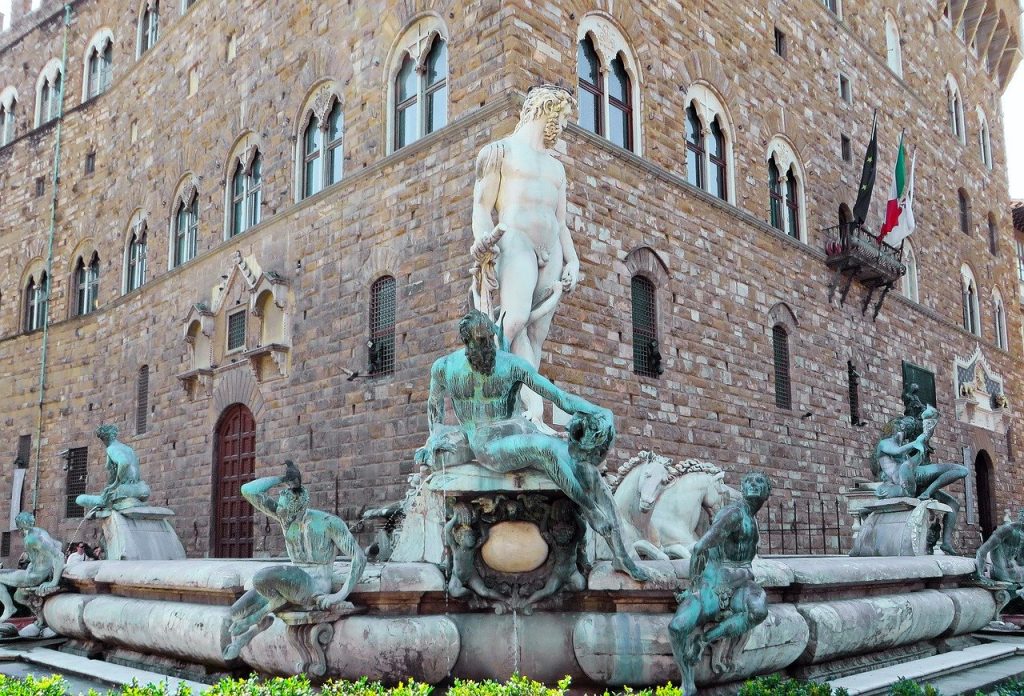
The Piazza della Signoria is an L shaped square that sits in front of the Palazzo Vecchio. The piazza has been at the heart of Florentine politics for centuries with citizens once called to meetings in the piazza by the bell of the Palazzo Vecchio. Nowadays it tends to be more a meeting point for locals and tourists alike, with holidaymakers flocking to the square to admire the wealth of statues that it is home to. Certainly, the most famous of these is the replica of Michelangelo’s David however this outdoor sculpture gallery is home to numerous other statues that commemorate the city’s historical events many of which are protected by the 14th Loggia dei Lanzi. Besides the statue of David, some of the other most famous include Giambologna’s Rape of the Sabine Women (1583) and a bronze statue of Perseus beheading Medusa (1554). The piazza is also home to the Fountain of Neptune.
41. Discover the sculptures in the Palazzo del Bargello
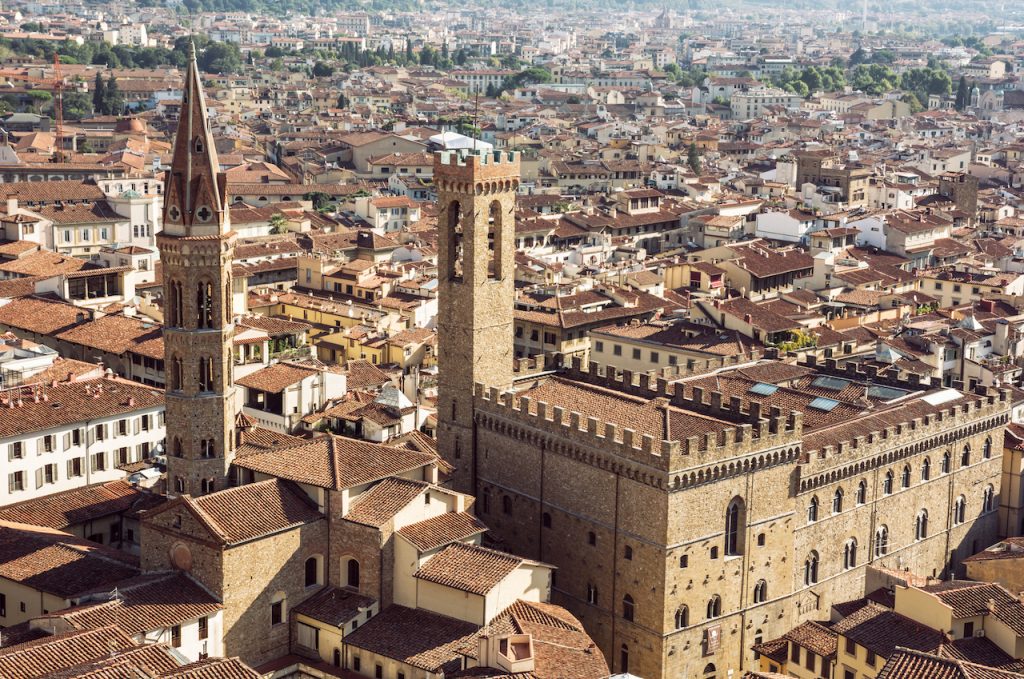
If you have a love of sculpture and want to see more, then you definitely need to head to the Palazzo del Bargello. Over the years, this rather austere fortress has been used as a residence for the Captain of Justice and as a prison, but these days, it’s home to the Bargello Museum. For lovers of Renaissance art, the latter is to sculpture what the Uffizi is to paintings. An entrance hall leads to a courtyard where visitors can admire works by Nicola Pisano amongst others. Other rooms contain works by Donatello, Ammannati, Michelangelo, Cellini and others. One of our favourite pieces is a display showing the competition entries of both Brunelleschi and Ghiberti who were competing to decorate the North doors of the Baptistry in the Piazza del Duomo. As you will know, Ghiberti ultimately won (and holidaymakers can view his completed doors in the Museo dell’ Opera today) but it’s interesting to see and compare the two entries.
42. Admire the original statue of David in the Galleria dell’ Accademia
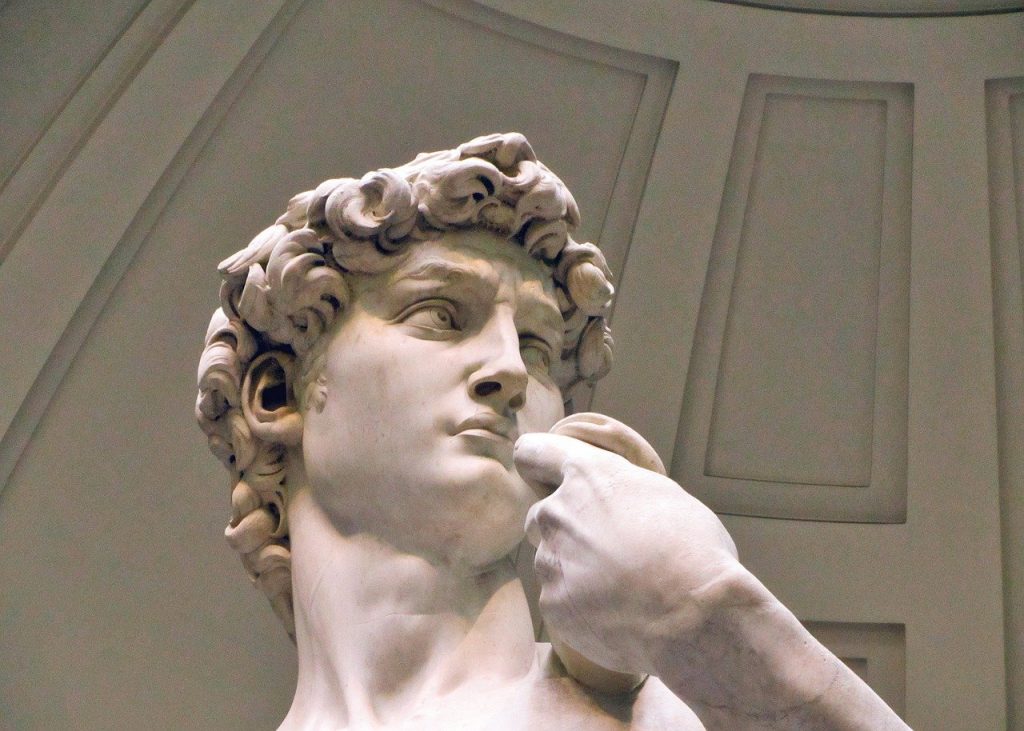
Whilst there is a copy of Michelangelo’s David in the Piazza della Signoria, the original is in the Accademia, moved here in 1873 following riots in the city which damaged the statue. The nude statue is larger than many people expect standing at over 5 metres tall. It’s not the only Michelangelo sculpture in the Accademia though. Michelangelo’s Quattro Prigionieri (Four Prisoners) is also exhibited here and there are also numerous artworks by other accomplished artists including Fra Bartolomeo, Botticelli and Ghirlandaio amongst others.
43. Take a hot air balloon ride
If you fancy seeing Florence from above, then how about enjoying a hot air balloon ride? There are a number of companies that offer them. A couple worth looking at if you want more details are Tuscany Ballooning and Ballooning in Tuscany. A hot air balloon is an incredibly special way to view the beauty of the region, flying above the skyline of Florence.
Book a hot air balloon ride over Florence.
44. Visit the Jewish synagogue
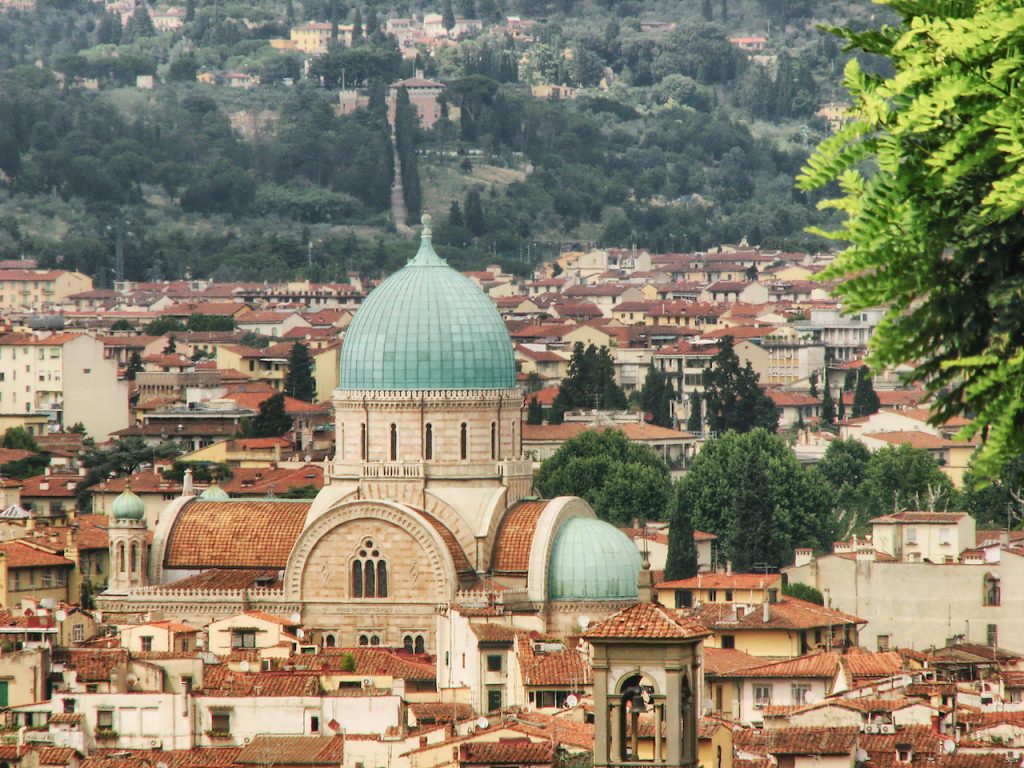
Whilst Italy is predominantly Catholic and dominated by its churches, it’s worth visiting Florence’s synagogue – Tempio Maggiore. It’s one of the largest synagogues in Europe and boasts a beautiful turquoise dome. Built thanks to David Levi who left the funds to build this in his will following his death in 1870, the interior is spectacularly colourful. Hitler’s armies tried to destroy the building when they retreated in 1944 but failed thanks to Italian resistance fighters successfully defusing most of the explosives that they had left.
45. Enjoy a festival
Italy is renowned for its annual calendar of festivals and Florence is no exception. Kicking off on 6 January with Epiphany when a ‘Cavalcade of the Three Kings’ processes through the streets, there are festivals to be celebrated in most months. Some of our favourites include the Carnevale in February when enormous, colourful floats parade through the city to the Piazza della Signoria, and the feast of the Annunciation in March when another parade fills the streets, this time with those taking part dressed in traditional Medieval costumes. We also love the Scoppio del Carro in April. This festival dates back 400 years and involves the dragging of a wagon through the city by white oxen. The wagon is filled with fireworks which explode when hit with a dove-shaped rocket fired from the altar of the Cathedral of Santa Maria del Fiore. Later in the year, La Festa della Rificolone (Festival of the Paper Lanterns) in September is a very pretty event when the people of Florence wander through the streets carrying paper lanterns lit by candles.
46. Visit the world’s oldest pharmacy
Situated in the monk’s infirmary in the Basilica Santa Maria Novella in Florence and established in 1221 by Dominican monks, the Officina Profumo-Farmaceutica is certainly amongst the oldest, if not the oldest pharmacy in the world. The shop is still in use today and is absolutely stunning with frescoes, gilded ceilings and elegant wooden cabinets housing old glass medicine bottles. Visitors will also be struck immediately by the wonderful smells and fragrances of the herbs and spices used to make their products. Pick up an ancient remedy or use the computerised catalogue to learn about the history of each product.
47. Shop for souvenirs to take home
No visit to Florence would be complete without a trip to find a souvenir to remember your trip by and one great option is to purchase something that the city has been famous for centuries – leather goods. Thanks to its position on the River Arno which provided a vital source of water necessary for the tanning process, Florence has a tradition of working leather dating back to antiquity. In the Middle Ages, leather was used for shoes, armour and ceremonial dress, saddles as well as books. Leather covers were made to protect books but parchment sheets were also made from cured sheepskin. Since the early 20th century, Florentine leather makers also became famous for their leather bags and luggage, thanks in large part to Guccio Gucci. Nowadays, there are a wealth of options on where to buy from high end luxury boutiques to market stalls. You’ll also find that prices vary considerably dependent on the quality of the leather. As a general rule, try and buy direct from the maker if you possibly can.
48. Admire the robes of St Francis
Few have heard of the Church of Ognissanti and yet this small church is actually home to the robes of St Francis of Assisi. That’s not all there is to see here though. It is also the resting place of Botticelli who worked here in the 15th century painting a fresco of Saint Augustine in his study. There are also some impressive works by Ghirlandaio here, including frescoes of the Madonna of Mercy and the Pieta as well as one of this best works of art, the Last Supper.
49. Join the English-speaking community at St Mark’s English Church
Certainly not what you expect in the middle of Florence, but St Mark’s Church in Florence, located in an old Medici Palace, is where you can enjoy a taste of home surrounded by an active English-speaking community. The church hosts regular concerts and talks and sings an Anglican mass every Sunday.
50. Marvel at the manuscripts in the Laurentian Library
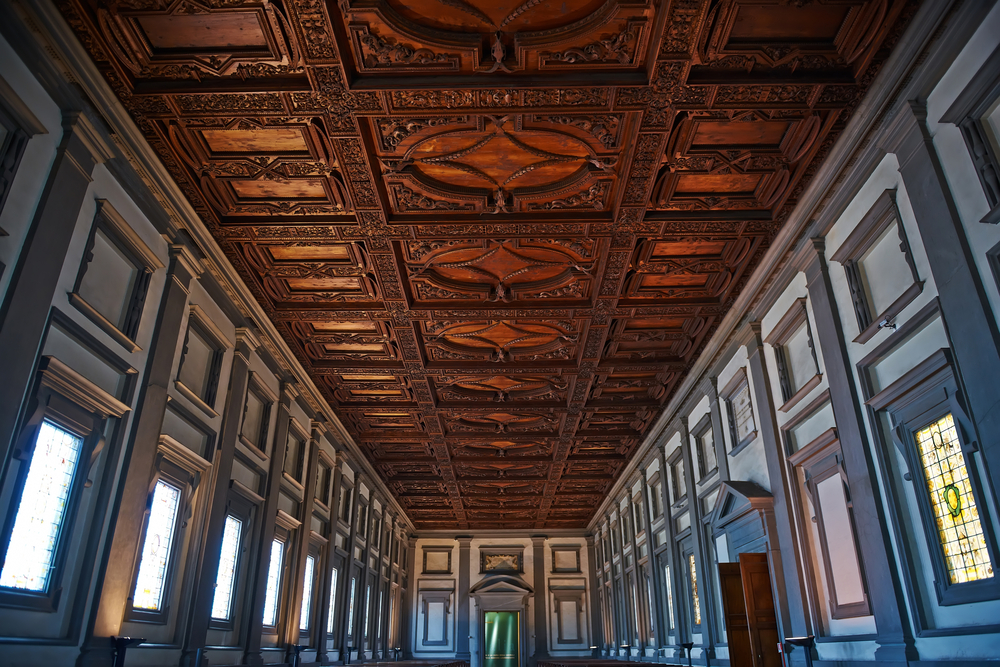
Accessed from the Basilica of San Lorenzo, the Laurentian Library in Florence is probably the most important collection of manuscripts in the world, passed down by the Medici family. Nowadays, this is now a museum rather than a library. Visitors will have a chance to see the long rectangular reading room, with row upon row of bookshelves and benches, stained glass windows and a beautifully intricately carved wooden ceiling. There is also a second area in the museum, home to an incredible collection of maps. The museum also has a small collection of historical books on display for visitors to see. It’s also a chance to marvel at one of the finest examples of the design and architecture of Michelangelo.
51. Visit the Zoological and Anatomical Museum
If animals are more your thing than books, then why not try a visit to La Specola instead. This is the oldest scientific museum in Europe and has a massive variety of exhibits including many stuffed animals. One that you least expect to see in a Florence museum is a hippopotamus that, believe it or not, once lived in the Boboli Gardens as a pet of the Medici family. Other unusual exhibits include the world’s largest collection of anatomical waxes.
52. Learn about an iconic fashion designer
Visitors are spoilt for choice when it comes to museums in Florence. If you’re a lover of fashion and design, then a great option is the Gucci Garden. On the ground floor of the building is the Gucci store, but the upper two floors are home to a museum which tells the story of the Gucci fashion house from its early beginnings in Florence. Original pieces are on display and for fashionistas, it is a must!
53. Uncover the gems inside the Museo Stibbert
One of the least well-known museums in Florence, the Stibbert Museum owes its existence to Frederick Stibbert who donated his villa and gardens to the city of Florence when he died in 1906. Stibbert was a rich gentleman who had inherited considerable wealth from his grandfather who was Commander in Chief for the British East India Company at the end of the 18th century. Frederick Stibbert didn’t work but instead devoted his life to the collection of interesting objects, antiques and artefacts, essentially turning his villa into a museum. Inside, there are a fascinating array of objects from displays of armour to collections of porcelain and Etruscan artefacts. One of the items most tourists are keen to see however is the cloak of Napolean. In total there are over 36,000 artefacts on display in 57 rooms.
54. Take a boat ride on the River Arno
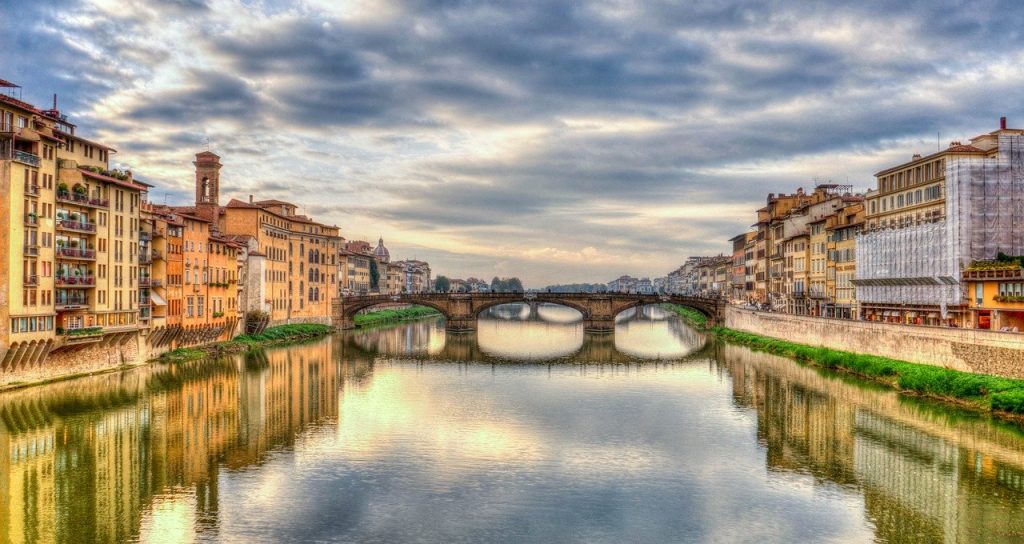
Whilst you certainly won’t find pleasure cruisers heading up and down the River Arno as you would on the River Seine in Paris, or find the gondoliers that you’d find on the canals of Venice, it is possible to take a trip on the Arno by boat. What is more, there are even companies offering trips in gondola style boats these days.
Book a boat tour of Florence.
55. Go paddle-boarding
Another option if you fancy heading out on the water is to try paddle-boarding. This will certainly give you a different perspective on the city and allow you to pass underneath the famous Ponte Vecchio. It also allows a little escape from the heat of the city in peak Summer months.
56. Enjoy a pint!
Whilst most visitors to Florence may be more interested in the wine than the beer, there is a craft brewery situated in the heart of the city. The Archea brewery has opened a brew pub in the city, just a stone’s throw from Piazza Santa Spirito where you can taste dozens of craft beers from all over the world. The Archea beer is made in Italy but not in Tuscany. If you want to try a more local beer, then another option is to head to one of the oldest beer pubs in the city – Il Bovaro – where you can try out their very own Riki beer.
57. Get a glimpse of how the locals live in the Piazza Santa Spirito
There are plenty of squares to be enjoyed in Florence but arguably the one where you will find most locals is the Piazza Santa Spirito. In the Oltrano district of the city, on the other side of the River Arno from many of the main attractions, it enjoys an authenticity that gives you a Glimpse into the life of a local. In the morning, you’ll find it bustling with street markets whilst in the evenings, you’ll find the locals enjoying an aperitivo.
58. Marvel at the Appennine Colossus
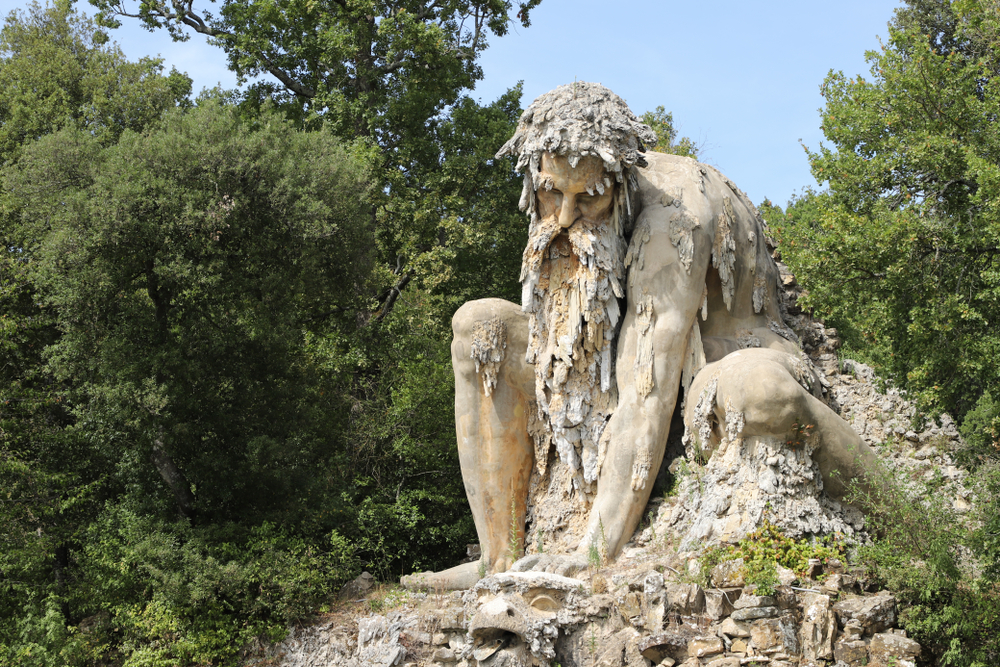
Whilst strictly 7 miles outside Florence, we thought we should sneak this into our top 60 list of things to do in Florence. This epic colossus is half man, half mountain, almost erupting from the mountain beneath and was erected by the Italian sculptor Giambologna. Standing over 35 feet tall, the statue can be found in the gardens of the Villa Demidoff. Inside the statue are a series of rooms which bring the statue to life…. A fireplace in his head would enable smoke to blow out of his nostrils whilst water would spill over his right hand from an underground stream.
59. Enjoy an exhibition at the Palazzo Strozzi
The Palazzo Strozzi is a palace built in the late 15th and early 16th centuries. Each year it holds an extensive programme of exhibitions and events focused on art whilst its Renaissance courtyard is the setting for temporary art installations, concerts and performances. Check out their website for more details.
60. Find out more about the founder of modern science at the Galileo Museum
The Museo Galileo in Florence is home to one of the largest collection of scientific instruments in the world and reflects the fact that Florence has been as interested in science for centuries as it has been in art. The Medici family certainly encouraged scientific research and this was continued by the Lorraine family in the 17th century. A visit to the museum will also provide you with the opportunity to see Galileo’s original instruments. Galileo Galilei arguably did more than anyone else to bring about the birth of modern science.
If we’ve whetted your appetite enough, then take a look at the phenomenal villas and apartments in Florence available to rent for your next holiday through Bookings For You.
